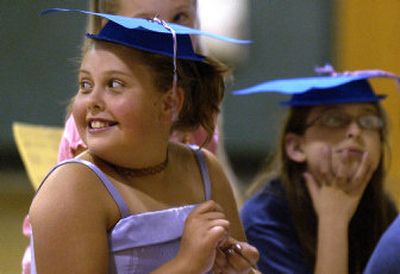In it for the academic long haul

Next week Madison Steiner and her sister, Kendall, will begin their summer school vacation – two weeks later than students at other schools. They’ll be back in school the middle of August.
Madison, 12, and Kendall, 9, have never known anything different. They’ve attended Continuous Curriculum School in the East Valley School District since they were kindergartners.
CCS students attend school 180 days per year, the same number as other students in the state, but their calendar is similar to what is used in Europe.
Students at CCS have six weeks off during the summer rather than 10 weeks, but they also have a week off in October, November and May and two weeks off in February, along with the usual Thanksgiving, winter and spring breaks that other schools in the East Valley district have.
“I love all the breaks that we get. We have about the same time off as on. We like to visit different places, and we get all the benefits of going in the winter and fall,” said Madison.
“I don’t feel like I’m missing anything. The time off in the summer feels like the 10 weeks everyone else gets,” said Kendall.
The girls’ mom, Cindy Steiner, discovered the K-8 school when she attended a kindergarten roundup for the school district seven years ago.
Steiner and her husband Ralph liked the fact that the year-round calendar allowed for several family vacations during the school year. They also liked the philosophy of the small school that emphasized parent involvement and community.
“It has a private school feel without the cost,” Steiner said.
Each family is expected to contribute 48 hours per year to CCS instruction. Some parents volunteer in the classroom, some tutor, some correct papers.
“All the parents here give as much as they can. There’s lots of parent involvement. We’re all friends. Our kids have grown up together,” said Steiner.
Steiner said 42 students and parents are planning a trip to Washington, D.C., to learn about U.S. history during the October break.
Academic expectations are high. Students benefit from the consistency of multiple-year placements with the same teacher . For example, Jill Shillam was Madison’s teacher for kindergarten, first and second grade.
“Jill Shillam was one of the reasons we decided to go to school here. When I met Jill I knew it was a good fit,” Steiner said.
Shillam has been a teacher at CCS since it opened 10 years ago. Her two daughters, ages 8 and 10, attend the school as well.
It’s not uncommon to have parents or grandparents in the classroom.
“The message is you’re welcome here,” Shillam said.
Shillam asks parents why they’ve chosen to send their children to CCS.
“The number one answer is the calendar, followed by parent involvement, high test scores and that they heard good things about us,” said Shillam.
tudies find both benefits and disadvantages to a year-round calendar.
The major benefit is that because students aren’t out of school for a long period of time they forget less over the shorter breaks so teachers spend less time reviewing material.
Another benefit of year-round education is that schools can offer remedial and enrichment classes to some of the students between sessions.
One of the few disadvantages, Steiner said, is that CCS doesn’t have its own sports programs. This can become an issue as the students get older. Although they could participate at the district’s other middle schools, their dismissal times are different, which makes it difficult.
Studies also indicate the schedule can be inconvenient for families with children who are in both traditional and year-round schools.
As far as achievement goes, overall the results are mixed and inconclusive.
“Your high-achieving students will do well anywhere, but for low to average students we can see big gains. Just when students get to the point where they’re getting burned out and start tuning everything out, they get a break. They come back refreshed and ready to go again. I’m not saying we’re better, but we offer a different option,” said Shillam.